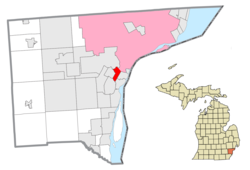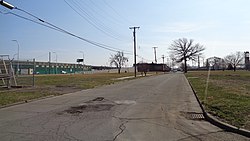
Wayne County is the most populous county in the U.S. state of Michigan. As of 2020, the United States Census placed its population at 1,793,561, making it the 19th-most populous county in the United States. The county seat is Detroit. The county was founded in 1796 and organized in 1815. Wayne County is included in the Detroit-Warren-Dearborn, MI Metropolitan Statistical Area. It is one of several U.S. counties named after Revolutionary War-era general Anthony Wayne.

Dearborn is a city in Wayne County in the U.S. state of Michigan. At the 2020 census, it had a population of 109,976. Dearborn is the seventh-largest city in Michigan.
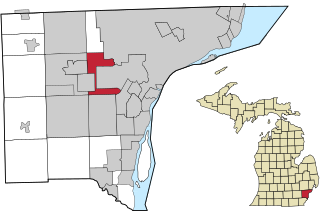
Dearborn Heights is a city in Wayne County in the U.S. state of Michigan. With a population of 63,292 at the 2020 census., Dearborn Heights is part of the Detroit metropolitan area, and is considered a bedroom community.
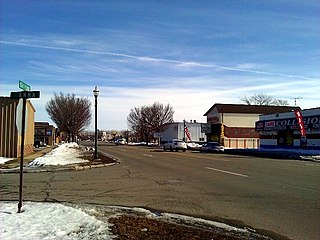
Melvindale is a city in Wayne County of the U.S. state of Michigan. At the 2020 census, the city population was 12,851.
Ecorse Township is a defunct civil township in Wayne County in the U.S. state of Michigan.

Zug Island is a heavily industrialized island within the city of River Rouge at the southern city limits of Detroit in the U.S. state of Michigan. It is located where the mouth of the River Rouge spills into the Detroit River. Zug Island is not a natural island in the river; it was formed when a shipping canal was dug along the southwestern side of the island, allowing ships to bypass several hundred yards of twisting waterway near the mouth of the natural course of the lowest portions of the River Rouge.
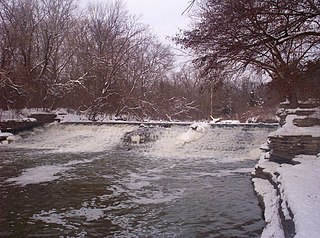
The River Rouge is a 127-mile river in the Metro Detroit area of southeastern Michigan. It flows into the Detroit River at Zug Island, which is the boundary between the cities of River Rouge and Detroit.

Downriver is the unofficial name for a collection of 19 cities and townships in Wayne County, Michigan, south of Detroit, along the western shore of the Detroit River.
Warrendale is a neighborhood located in Detroit, Michigan, bordered by Greenfield Road, Joy Road, and the Detroit city limits. Warrendale neighbors Dearborn on two sides and Dearborn Heights on another side.

Delray is a neighborhood in southwest Detroit in the U.S. state of Michigan. Its area extends south to the River Rouge, east to the Detroit River, west to Fort Street, and north to Clark Street. The two census tracts that cover the neighborhood had a population of 2,783 at the 2010 census.
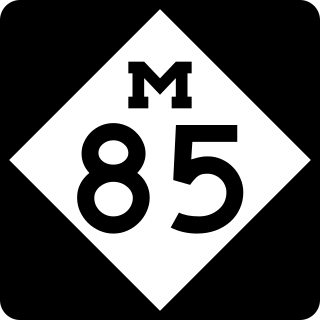
M-85, also known as Fort Street or Fort Road for its entire length, is a state trunkline highway in the U.S. state of Michigan. The highway serves several Downriver suburbs of Detroit, as well as neighborhoods in the city itself. From its southern terminus at exit 28 on Interstate 75 (I-75) to its second interchange with exit 43 on I-75 in southwest Detroit, M-85 is part of the Lake Erie Circle Tour. In between, it serves mostly residential areas running parallel to a pair of rail lines; the highway carries between 5,000 and 43,000 vehicles per day on average. Once in the city of Detroit, Fort Street runs parallel to I-75 for several miles before they separate near the Ambassador Bridge. The northern end of M-85 is at the intersection with Griswold Street in downtown Detroit, one block away from Campus Martius Park.
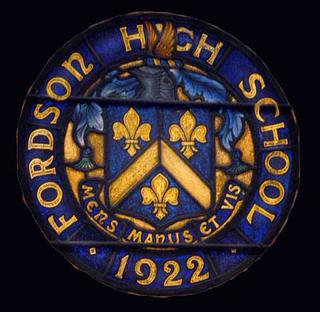
Fordson High School is a secondary school located in Dearborn, Michigan, United States in Greater Detroit. It was completed in 1928 on a 15-acre (61,000 m2) parcel of land which was then the village of Fordson, named for Henry Ford and his son Edsel Ford. It is a part of Dearborn Public Schools.

Edsel Ford High School is a public high school located in Dearborn, Michigan, USA in Greater Detroit. Edsel Ford, located on Rotunda Drive, near Oakwood, is one of three public high schools in the Dearborn Public Schools. Edsel Ford High School was completed in 1955, and the first graduating class was in 1956.
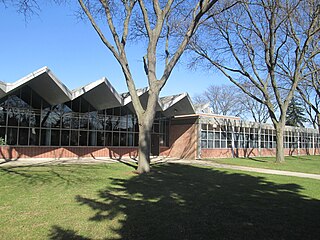
The Dearborn Public Schools is a school district that includes the entire city of Dearborn, Michigan and a small portion of Dearborn Heights, both in Greater Detroit. Dearborn Public Schools is the third largest school district in Michigan, serving 20,000 students. The district had a $233 million budget for 2021.
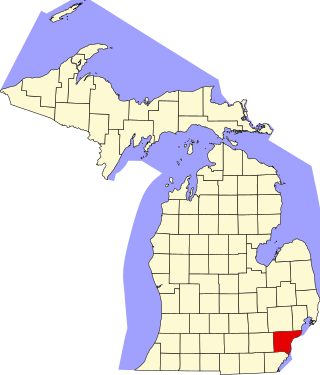
This is a list of the National Register of Historic Places listings in Wayne County, Michigan.

Dearborn High School (DHS) is a public high school located in Dearborn, Michigan. It was founded in 1893 in Dearborn near Greater Detroit. Dearborn High is one of the three high schools of the Dearborn City School District and is located at 19501 Outer Drive. There are over 2,000 students currently attending Dearborn High.
Springwells Township is a defunct civil township in Wayne County, in the U.S. state of Michigan. All of the land is now incorporated as part of the cities of Detroit and Dearborn. Springwells is also famously known as the birthplace of Henry Ford.

The Fort Street–Pleasant Street and Norfolk & Western Railroad Viaduct is a bridge carrying six lanes of Fort Street over both Pleasant Street and multiple tracks comprising the Norfolk Southern Railway Detroit District and Conrail Shared Assets Lincoln Secondary and Junction Yard Secondary lines on the border of the Boynton and Oakwood Heights neighborhoods in Detroit, Michigan, just west of the Rouge River. It was listed on the National Register of Historic Places in 2000. The bridge underwent massive repairs and other construction in late 2010 and throughout much of 2011, which included narrowing the Fort Street boulevard north of the viaduct into a six-lane undivided road with a left-turns-only lane. The bridge was removed from the NRHP in 2022.

This is a list of trails and greenways in Detroit.

Fordson Island is a 8.4-acre (3.4 ha) artificial island in the River Rouge, in southeast Michigan. It was created by the Ford Motor Company in 1918, while dredging the River Rouge, and the land was donated to Springwells Township by Henry Ford. It eventually became part of the City of Dearborn, which became aware of its existence in 1980; since its creation, it has been home to liquor smugglers, industrial facilities, several residents, a marina, and numerous abandoned watercraft. By the mid-1980s, the island was mostly uninhabited; in the early 2000s numerous abandoned vessels were dumped on its shores.

